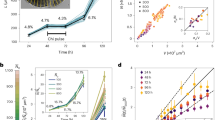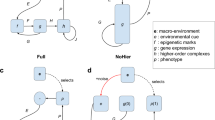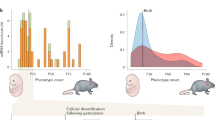Abstract
Animal development is an extremely robust process resulting in stereotyped outcomes. Canalization is a design principle wherein developmental pathways are stabilized to increase phenotypic reproducibility. Recent revelations into microRNA (miRNA) function suggest that miRNAs act as key players in canalizing genetic programs. We suggest that miRNA interactions with the network of protein-coding genes evolved to buffer stochastic perturbations and thereby confer robustness to developmental genetic programs.
This is a preview of subscription content, access via your institution
Access options
Subscribe to this journal
Receive 12 print issues and online access
$209.00 per year
only $17.42 per issue
Buy this article
- Purchase on Springer Link
- Instant access to full article PDF
Prices may be subject to local taxes which are calculated during checkout



Katie Ris
Similar content being viewed by others
References
Waddington, C.H. Canalization of development and the inheritance of acquired characters. Nature 150, 563–565 (1942).
Rendel, J.M. A model relating gene replicas and gene repression to phenotypic expression and variability. Proc. Natl. Acad. Sci. USA 64, 578–583 (1969).
Gibson, G. & Wagner, G. Canalization in evolutionary genetics: a stabilizing theory? Bioessays 22, 372–380 (2000).
Flatt, T. The evolutionary genetics of canalization. Q. Rev. Biol. 80, 287–316 (2005).
Queitsch, C., Sangster, T.A. & Lindquist, S. Hsp90 as a capacitor of phenotypic variation. Nature 417, 618–624 (2002).
Rutherford, S.L. & Lindquist, S. Hsp90 as a capacitor for morphological evolution. Nature 396, 336–342 (1998).
Bartel, D.P. MicroRNAs: genomics, biogenesis, mechanism, and function. Cell 116, 281–297 (2004).
Lewis, B. P., Burge, C.B. & Bartel, D.P. Conserved seed pairing, often flanked by adenosines, indicates that thousands of human genes are microRNA targets. Cell 120, 15–20 (2005).
Xie, X. et al. Systematic discovery of regulatory motifs in human promoters and 3′ UTRs by comparison of several mammals. Nature 434, 338–345 (2005).
Stark, A., Brennecke, J., Bushati, N., Russell, R.B. & Cohen, S.M. Animal MicroRNAs confer robustness to gene expression and have a significant impact on 3′UTR evolution. Cell 123, 1133–1146 (2005).
Brennecke, J., Stark, A., Russell, R.B. & Cohen, S.M. Principles of microRNA-target recognition. PLoS Biol. 3, e85 (2005).
Grun, D., Wang, Y.L., Langenberger, D., Gunsalus, K.C. & Rajewsky, N. microRNA target predictions across seven Drosophila species and comparison to mammalian targets. PLoS Comput. Biol. 1, e13 (2005).
Farh, K.K. et al. The widespread impact of mammalian MicroRNAs on mRNA repression and evolution. Science 310, 1817–1821 (2005).
Lee, R.C., Feinbaum, R.L. & Ambros, V. The C. elegans heterochronic gene lin-4 encodes small RNAs with antisense complementarity to lin-14. Cell 75, 843–854 (1993).
Wightman, B., Ha, I. & Ruvkun, G. Posttranscriptional regulation of the heterochronic gene lin-14 by lin-4 mediates temporal pattern formation in C. elegans. Cell 75, 855–862 (1993).
Reinhart, B.J. et al. The 21-nucleotide let-7 RNA regulates developmental timing in Caenorhabditis elegans. Nature 403, 901–906 (2000).
Lin, S.Y. et al. The C elegans hunchback homolog, hbl-1, controls temporal patterning and is a probable microRNA target. Dev. Cell 4, 639–650 (2003).
Johnston, R.J. & Hobert, O. A microRNA controlling left/right neuronal asymmetry in Caenorhabditis elegans. Nature 426, 845–849 (2003).
Brennecke, J., Hipfner, D.R., Stark, A., Russell, R.B. & Cohen, S.M. bantam encodes a developmentally regulated microRNA that controls cell proliferation and regulates the proapoptotic gene hid in Drosophila. Cell 113, 25–36 (2003).
Abrahante, J.E. et al. The Caenorhabditis elegans hunchback-like gene lin-57/hbl-1 controls developmental time and is regulated by microRNAs. Dev. Cell 4, 625–637 (2003).
Bernstein, E. et al. Dicer is essential for mouse development. Nat. Genet. 35, 215–217 (2003).
Cobb, B.S. et al. T cell lineage choice and differentiation in the absence of the RNase III enzyme Dicer. J. Exp. Med. 201, 1367–1373 (2005).
Giraldez, A.J. et al. MicroRNAs regulate brain morphogenesis in zebrafish. Science 308, 833–838 (2005).
Harfe, B.D., McManus, M.T., Mansfield, J.H., Hornstein, E. & Tabin, C.J. The RNaseIII enzyme Dicer is required for morphogenesis but not patterning of the vertebrate limb. Proc. Natl. Acad. Sci. USA 102, 10898–10903 (2005).
Muljo, S.A. et al. Aberrant T cell differentiation in the absence of Dicer. J. Exp. Med. 202, 261–269 (2005).
Harris, K.S., Zhang, Z., McManus, M.T., Harfe, B.D. & Sun, X. Dicer function is essential for lung epithelium morphogenesis. Proc. Natl. Acad. Sci. USA 103, 2208–2213 (2006).
John, B. et al. Human microRNA targets. PLoS Biol. 2, e363 (2004).
Krek, A. et al. Combinatorial microRNA target predictions. Nat. Genet. 37, 495–500 (2005).
Lewis, B.P., Shih, I.H., Jones-Rhoades, M.W., Bartel, D.P. & Burge, C.B. Prediction of mammalian microRNA targets. Cell 115, 787–798 (2003).
Chang, S., Johnston, R.J., Jr., Frokjaer-Jensen, C., Lockery, S. & Hobert, O. MicroRNAs act sequentially and asymmetrically to control chemosensory laterality in the nematode. Nature 430, 785–789 (2004).
Mangan, S. & Alon, U. Structure and function of the feed-forward loop network motif. Proc. Natl. Acad. Sci. USA 100, 11980–11985 (2003).
Johnston, R.J., Jr., Chang, S., Etchberger, J.F., Ortiz, C.O. & Hobert, O. MicroRNAs acting in a double-negative feedback loop to control a neuronal cell fate decision. Proc. Natl. Acad. Sci. USA 102, 12449–12454 (2005).
Hornstein, E. et al. The microRNA miR-196 acts upstream of Hoxb8 and Shh in limb development. Nature 438, 671–674 (2005).
Ronshaugen, M., Biemar, F., Piel, J., Levine, M. & Lai, E.C. The Drosophila microRNA iab-4 causes a dominant homeotic transformation of halteres to wings. Genes Dev. 19, 2947–2952 (2005).
Bartel, D.P. & Chen, C.Z. Micromanagers of gene expression: the potentially widespread influence of metazoan microRNAs. Nat. Rev. Genet. 5, 396–400 (2004).
O'Donnell, K.A., Wentzel, E.A., Zeller, K.I., Dang, C.V. & Mendell, J.T. c-Myc-regulated microRNAs modulate E2F1 expression. Nature 435, 839–843 (2005).
Poy, M.N. et al. A pancreatic islet-specific microRNA regulates insulin secretion. Nature 432, 226–230 (2004).
Zhao, Y., Samal, E. & Srivastava, D. Serum response factor regulates a muscle-specific microRNA that targets Hand2 during cardiogenesis. Nature 436, 214–220 (2005).
Schratt, G.M. et al. A brain-specific microRNA regulates dendritic spine development. Nature 439, 283–289 (2006).
Sood, P., Krek, A., Zavolan, M., Macino, G. & Rajewsky, N. Cell-type-specific signatures of microRNAs on target mRNA expression. Proc. Natl. Acad. Sci. USA 103, 2746–2751 (2006).
Giraldez, A.J. et al. Zebrafish MiR-430 promotes deadenylation and clearance of maternal mRNAs. Science 312, 75–79 (2006).
Barkai, N. & Leibler, S. Robustness in simple biochemical networks. Nature 387, 913–917 (1997).
Lenski, R.E., Ofria, C., Collier, T.C. & Adami, C. Genome complexity, robustness and genetic interactions in digital organisms. Nature 400, 661–664 (1999).
Lim, L.P. et al. Microarray analysis shows that some microRNAs downregulate large numbers of target mRNAs. Nature 433, 769–773 (2005).
Yekta, S., Shih, I.H. & Bartel, D.P. MicroRNA-directed cleavage of HOXB8 mRNA. Science 304, 594–596 (2004).
Raser, J.M. & O'Shea, E.K. Noise in gene expression: origins, consequences, and control. Science 309, 2010–2013 (2005).
Arias, A.M. & Hayward, P. Filtering transcriptional noise during development: concepts and mechanisms. Nat. Rev. Genet. 7, 34–44 (2006).
Thattai, M. & van Oudenaarden, A. Intrinsic noise in gene regulatory networks. Proc. Natl. Acad. Sci. USA 98, 8614–8619 (2001).
Paulsson, J. Summing up the noise in gene networks. Nature 427, 415–418 (2004).
Swain, P.S., Elowitz, M.B. & Siggia, E.D. Intrinsic and extrinsic contributions to stochasticity in gene expression. Proc. Natl. Acad. Sci. USA 99, 12795–12800 (2002).
Blake, W.J., Kaern, M., Cantor, C.R. & Collins, J.J. Noise in eukaryotic gene expression. Nature 422, 633–637 (2003).
Ozbudak, E.M., Thattai, M., Kurtser, I., Grossman, A.D. & van Oudenaarden, A. Regulation of noise in the expression of a single gene. Nat. Genet. 31, 69–73 (2002).
Waddington, C.H. Genetic assimilation of the Bithorax phenotype. Evolution Int. J. Org. Evolution 10, 1–13 (1956).
Kirschner, M. & Gerhart, J. Evolvability. Proc. Natl. Acad. Sci. USA 95, 8420–8427 (1998).
Masel, J. Cryptic genetic variation is enriched for potential adaptations. Genetics 172, 1985–1991 (2006).
Sokol, N.S. & Ambros, V. Mesodermally expressed Drosophila microRNA-1 is regulated by Twist and is required in muscles during larval growth. Genes Dev. 19, 2343–2354 (2005).
Brennecke, J., Stark, A. & Cohen, S.M. Not miR-ly muscular: microRNAs and muscle development. Genes Dev. 19, 2261–2264 (2005).
Meir, E., von Dassow, G., Munro, E. & Odell, G.M. Robustness, flexibility, and the role of lateral inhibition in the neurogenic network. Curr. Biol. 12, 778–786 (2002).
Lai, E.C. Micro RNAs are complementary to 3′ UTR sequence motifs that mediate negative post-transcriptional regulation. Nat. Genet. 30, 363–364 (2002).
Lai, E.C., Tam, B. & Rubin, G.M. Pervasive regulation of Drosophila Notch target genes by GY-box-, Brd-box-, and K-box-class microRNAs. Genes Dev. 19, 1067–1080 (2005).
Stark, A., Brennecke, J., Russell, R.B. & Cohen, S.M. Identification of Drosophila MicroRNA targets. PLoS Biol. 1, E60 (2003).
Lewis, E.B. A gene complex controlling segmentation in Drosophila. Nature 276, 565–570 (1978).
Gibson, G. & Hogness, D.S. Effect of polymorphism in the Drosophila regulatory gene Ultrabithorax on homeotic stability. Science 271, 200–203 (1996).
Keller, E.F. Developmental robustness. Ann. NY Acad. Sci. 981, 189–201 (2002).
Nijhout, H.F. The nature of robustness in development. Bioessays 24, 553–563 (2002).
Wagner, G.P. Evolutionary genetics: the nature of hidden genetic variation unveiled. Curr. Biol. 13, R958–R960 (2003).
Rendel, J.M., Sheldon, B.L. & Finlay, D.E. Canalisation of development of scutellar bristles in Drosophila by control of the scute locus. Genetics 52, 1137–1151 (1965).
Gibson, G. & Dworkin, I. Uncovering cryptic genetic variation. Nat. Rev. Genet. 5, 681–690 (2004).
Acknowledgements
We would like to thank N. Barkai, U. Alon, G. Shinar, D. Bartel and S. Cohen for discussions. We thank E. McGlinn, R. Kafri and C. Burge for critical reading of the manuscript. E.H. acknowledges C. Tabin for inspiration, training and insightful remarks on this manuscript.
Author information
Authors and Affiliations
Ethics declarations
Competing interests
The authors declare no competing financial interests.
Rights and permissions
About this article
Cite this article
Hornstein, E., Shomron, N. Canalization of development by microRNAs. Nat Genet 38 (Suppl 6), S20–S24 (2006). https://doi.org/10.1038/ng1803
Published:
Issue Date:
DOI: https://doi.org/10.1038/ng1803
This article is cited by
-
Transcriptional and post-transcriptional regulation of checkpoint genes on the tumour side of the immunological synapse
Heredity (2022)
-
Genomic competition for noise reduction shaped evolutionary landscape of mir-4673
npj Systems Biology and Applications (2020)
-
Milk-derived miRNA profiles elucidate molecular pathways that underlie breast dysfunction in women with common genetic variants in SLC30A2
Scientific Reports (2019)
-
Dgcr8 knockout approaches to understand microRNA functions in vitro and in vivo
Cellular and Molecular Life Sciences (2019)
-
Direct measurement of pervasive weak repression by microRNAs and their role at the network level
BMC Genomics (2018)



